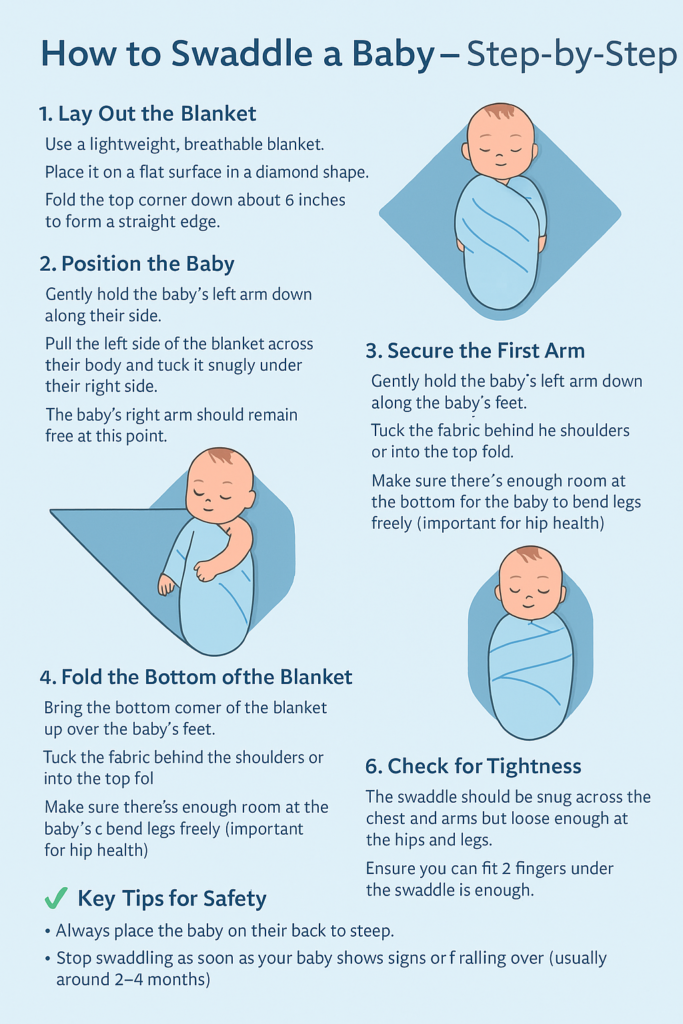Swaddling is a time-honored technique that can help soothe newborns, promote better sleep, and provide a sense of security by mimicking the snugness of the womb. However, it’s crucial to swaddle correctly to ensure your baby’s safety and comfort.
Benefits of Swaddling
- Reduces Startle Reflex: Helps prevent the Moro reflex from waking the baby.
- Promotes Better Sleep: Encourages longer and more restful sleep periods.
- Soothes Fussiness: Provides a calming effect for irritable infants.
- Creates a Secure Environment: Mimics the warmth and security of the womb.
Step-by-Step Guide to Safe Swaddling
- Prepare the Blanket: Lay a thin, breathable blanket on a flat surface in a diamond shape. Fold the top corner down about 6 inches.
- Position Your Baby: Place your baby face-up on the blanket with their head above the folded corner.
- Secure the First Arm: Gently straighten your baby’s left arm and wrap the left side of the blanket over their body, tucking it under their right side.
- Secure the Second Arm: Straighten the right arm and bring the right side of the blanket over your baby’s body, tucking it under the left side.
- Fold the Bottom: Fold the bottom of the blanket up over your baby’s feet, ensuring there’s room for hip movement.
- Check for Tightness: Ensure the swaddle is snug but not too tight. You should be able to fit two fingers between the blanket and your baby’s chest.
Note: Always place your baby on their back to sleep, whether swaddled or not, to reduce the risk of Sudden Infant Death Syndrome (SIDS).
Safety Tips and Guidelines
- Use Appropriate Materials: Choose lightweight, breathable fabrics to prevent overheating.
- Allow Hip Movement: Ensure the swaddle is loose around the hips and legs to promote healthy hip development and reduce the risk of hip dysplasia.
- Monitor Temperature: Keep the room at a comfortable temperature and avoid overdressing your baby under the swaddle.
- Discontinue Swaddling at the Right Time: Stop swaddling when your baby shows signs of rolling over, which can occur as early as 2 months of age. (Healthline)
Expert Recommendations
The American Academy of Pediatrics (AAP) provides guidelines on safe swaddling practices:
- Always place infants on their backs to sleep.
- Use a firm sleep surface free of soft bedding, pillows, or toys.
- Ensure the swaddle is not too tight, especially around the hips and chest.
- Discontinue swaddling once the baby attempts to roll over. (AAP Safe Sleep Guidelines)
When to Stop Swaddling
Swaddling can be a comforting practice for newborns, but there comes a time when it’s essential to transition your baby out of it to ensure their safety and comfort. Recognizing the signs that indicate it’s time to stop swaddling is crucial.
1. Attempts to Roll Over
One of the most critical indicators that it’s time to stop swaddling is when your baby shows signs of rolling over. This milestone typically occurs between 2 to 4 months of age. Once a baby can roll, swaddling can become dangerous because it restricts their ability to move freely, increasing the risk of suffocation if they roll onto their stomach while swaddled. (WebMD)
2. Breaking Free from the Swaddle
If your baby consistently breaks out of their swaddle, it may indicate that they no longer find it comfortable or that they are becoming more active. A loose swaddle can pose a safety hazard, as the loose fabric may cover the baby’s face, increasing the risk of suffocation. (Newton Baby)
3. Resisting Swaddling or Sleep Disruptions
Some babies begin to resist being swaddled, showing signs of discomfort or agitation when being wrapped. This resistance can lead to sleep disruptions, as the baby may struggle to settle or stay asleep. In such cases, it’s advisable to stop swaddling and explore alternative sleep solutions that allow more freedom of movement. (Pixsee Care)
Recognizing these signs and transitioning your baby out of swaddling at the appropriate time is essential for their safety and well-being. Always consult with your pediatrician if you have concerns about your baby’s sleep habits or the swaddling transition.
How to Swaddle a Baby – Step-by-Step
1. Lay Out the Blanket
- Use a lightweight, breathable blanket.
- Place it on a flat surface in a diamond shape (like a baseball field).
- Fold the top corner down about 6 inches to form a straight edge.
2. Position the Baby
- Lay the baby face-up on the blanket.
- Their shoulders should be just below the folded edge.
- Make sure arms are resting naturally by their sides or slightly bent.
3. Secure the First Arm
- Gently hold the baby’s left arm down along their side.
- Pull the left side of the blanket across their body and tuck it snugly under their right side.
- The baby’s right arm should remain free at this point.
4. Fold the Bottom of the Blanket
- Bring the bottom corner of the blanket up over the baby’s feet.
- Tuck the fabric behind the shoulders or gently into the top fold if there’s extra fabric.
- Make sure there’s enough room at the bottom for the baby to bend legs freely (important for hip health).
5. Secure the Second Arm
- Hold the baby’s right arm down.
- Pull the right side of the blanket across the body and around the left side, tucking it under securely.
6. Check for Tightness
- The swaddle should be snug across the chest and arms but loose enough at the hips and legs.
- Ensure you can fit 2 fingers between the baby’s chest and the blanket.
- Never cover the baby’s head or face.
✅ Key Tips for Safety
- Always place the baby on their back to sleep.
- Stop swaddling as soon as your baby shows signs of rolling over (usually around 2–4 months).
- Don’t overheat the baby – one light layer under the swaddle is enough.

Alternatives to Swaddling
As your baby outgrows swaddling, consider transitioning to sleep sacks or wearable blankets that allow for free movement while still providing a sense of security.
Additional Resources



